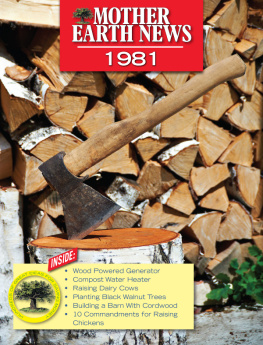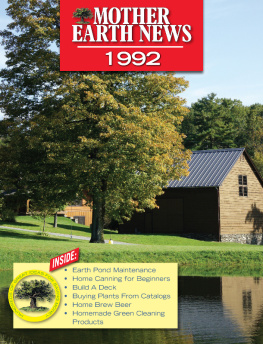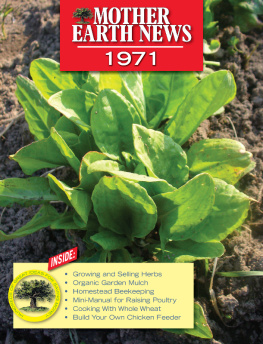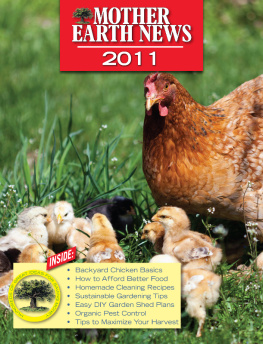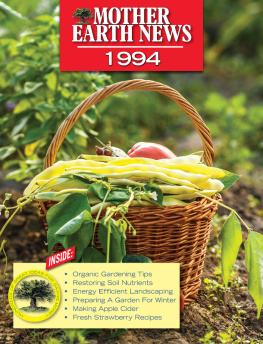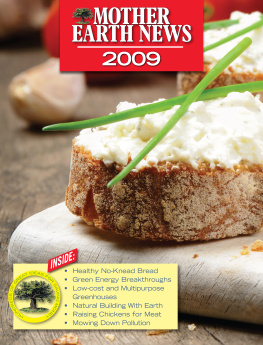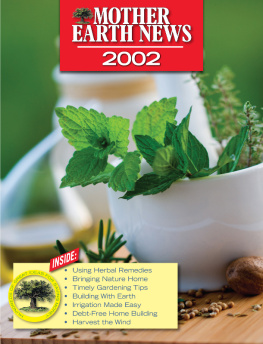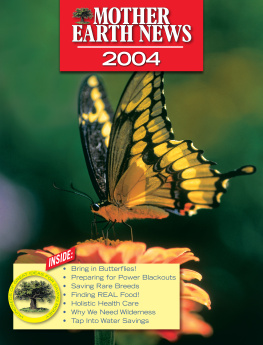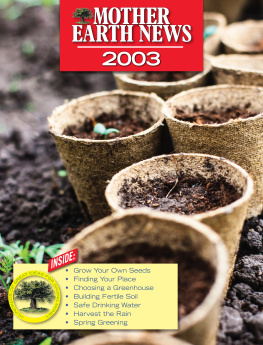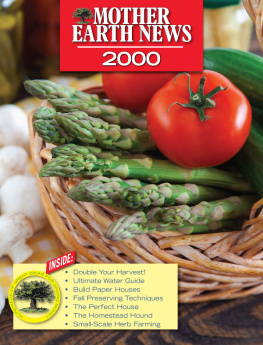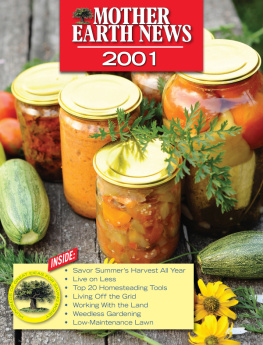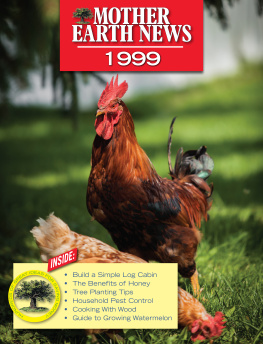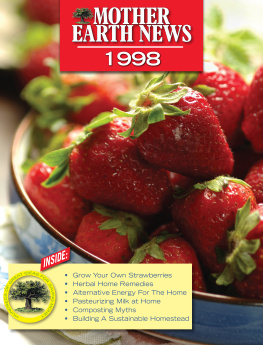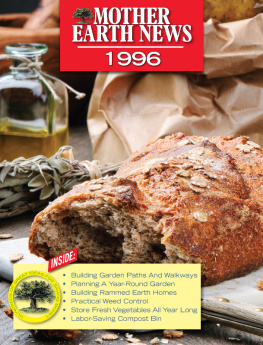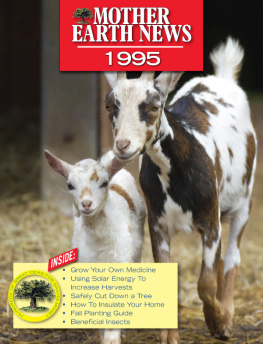Mother Earth News - Mother Earth News 1981
Here you can read online Mother Earth News - Mother Earth News 1981 full text of the book (entire story) in english for free. Download pdf and epub, get meaning, cover and reviews about this ebook. year: 1981, publisher: Mother Earth News, genre: Science / Home and family. Description of the work, (preface) as well as reviews are available. Best literature library LitArk.com created for fans of good reading and offers a wide selection of genres:
Romance novel
Science fiction
Adventure
Detective
Science
History
Home and family
Prose
Art
Politics
Computer
Non-fiction
Religion
Business
Children
Humor
Choose a favorite category and find really read worthwhile books. Enjoy immersion in the world of imagination, feel the emotions of the characters or learn something new for yourself, make an fascinating discovery.
- Book:Mother Earth News 1981
- Author:
- Publisher:Mother Earth News
- Genre:
- Year:1981
- Rating:3 / 5
- Favourites:Add to favourites
- Your mark:
- 60
- 1
- 2
- 3
- 4
- 5
Mother Earth News 1981: summary, description and annotation
We offer to read an annotation, description, summary or preface (depends on what the author of the book "Mother Earth News 1981" wrote himself). If you haven't found the necessary information about the book — write in the comments, we will try to find it.
Mother Earth News 1981 — read online for free the complete book (whole text) full work
Below is the text of the book, divided by pages. System saving the place of the last page read, allows you to conveniently read the book "Mother Earth News 1981" online for free, without having to search again every time where you left off. Put a bookmark, and you can go to the page where you finished reading at any time.
Font size:
Interval:
Bookmark:

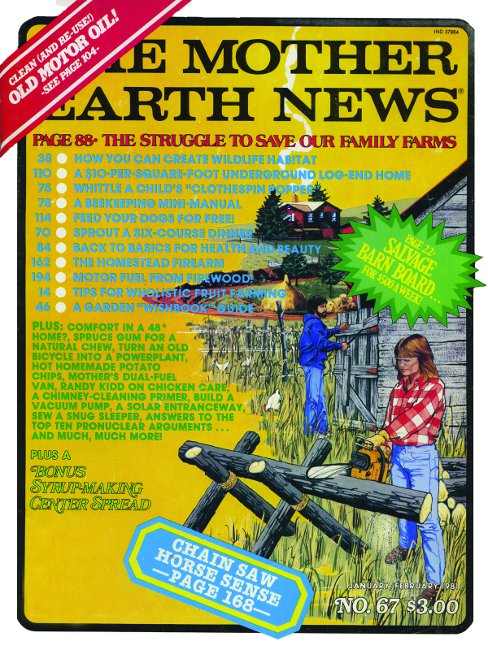
You dont find many pioneers like A. P. Thomson anymore: Hes a man who-more than 30 years ago-had the courage and foresight to buck the trend and put his maverick beliefs into practice despite the suspicion and skepticism of folks who just couldnt understand his vision for organic food production in general and an organic apples in particular.
A.P., you see, is an apple grower (just as his grandfather was) but unlike most modern commercial orchardists, this Virginian has never used a single agribiz chemical on his 35-acre farm in the rolling countryside of the Shenandoah Valley. Every year, Thomsons Golden Acres Orchard produces seven different varieties of organically grown apples in addition to unfiltered apple juice and apple cider vinegar. The pure products are sold-mostly by mail order-to customers all over the United States, including doctors, health food stores, co-ops, people who are allergic to common agricultural chemicals, and hundreds of individuals who simply prefer the fresh, untainted taste of A.P.s fruit.
After years of research and experimentation, Thomson has developed a system-consisting of a number of environmentally safe treatments and methods-to maintain his orchards soil fertility, grow hardy trees, repel insects and disease, and produce delicious apples (a fruit which is traditionally among the most difficult crops to grow without pesticide sprays).
Furthermore, A.P. is eager to pass on his vision, and to spread the word about wholistic farming to anyone wholl listen. He founded-in December of 1979-an organization called Friends of the Farm. Headed by Thomson and Illinois agriculturist Robert Rowe, FOF has already opened several demonstration sites across the country, giving people opportunities to learn the techniques of organic food production from actual working operations (such as A.P.s orchard).
Last autumn, MOTHER EARTH NEWS sent horticulturist Larry Hollar and writer Jeanne Malmgren to the Old Dominion state to visit A.P. at his Front Royal home. There, the amiable Virginian took our staffers on an extensive tour of his orchard, cold storage warehouse, apple packing facility, and experimental intensive garden. Afterward, Larry and Jeanne spent several hours talking with Thomson in his gracious, turn-of-the-century house, where they learned more about the orchard-keepers past and present work and about his hopes for the future. The following transcript-which was edited from that conversation-presents a portrait of the man as an agricultural researcher, a humanist, and a lifelong natural farmer. We hope youll enjoy meeting A. P. Thomson.
PLOWBOY: Mr. Thomson, evidence of your devotion to the cause of organic growing is everywhere on this farm: in the acres of healthy, unsprayed trees in the storage warehouse full of fragrant, wholesome fruit even in the 100-square-foot intensive vegetable plot in the back yard. Can you tell us a little about the events that led to your establishing an organic apple orchard?
THOMSON: It was a long road that brought me here. Believe it or not, when I was young I wanted to be a doctor. In fact, I majored in chemistry at Washington and Lee University, and even won an academic scholarship to Harvard Medical School. But-since we were right in the middle of the Depression then-my daddy, who was a farmer, couldnt get up the money for my room and board. So I went to Washington instead and found a job at the Bureau of the Mint, where I worked as a chemist until World War II broke out.
During that conflict, I joined the Navy and spent a couple of years at Pearl Harbor. While I was there, I often spent my free time leafing through books in the PX and thats how I stumbled onto Louis Bromfields farming classic, Pleasant Valley.
Well sir, that little book really lit a spark in me. After reading it, I understood why my fathers fields had eroded so badly and why our familys farm had suffered from low productivity for years. Since I already had an interest in nature and a strong desire to go back to the farm, I began to study agriculture in earnest and I followed up all the references in Bromfields book.
First, I wrote to Sir Albert Howard-who, as you know, is considered the founder of organic gardening-in England, and that initial contact led to a long correspondence. I also got in touch with Lady Eve Balfour, the first president of Great Britains Soil Association, and met her when she came to this country. Then I went to Pennsylvania to visit J. I. Rodale-the founder of Organic Gardening and Farming magazine-and see his experiments.
Remember, at that time the concept of organic or natural horticulture was still new, so I was very fortunate to meet and learn from the real pioneers in the field. And, as I became more knowledgeable, my interest grew and grew until I finally decided, Well, by George, Im going to go back home and help my family make a living out of the old place. The idea of starting an apple orchard had long been on my mind I guess because my granddaddy was an orchardist. But when I returned to the family farmstead, I found that it wasnt exactly an ideal place to raise fruit trees. The soil was so poor my father couldnt even grow enough corn to feed our one old cow, and there were washed-out gullies you could hide a house in!
So I had a real challenge facing me. I knew, first of all, that Id have to revive that soil somehow. The top priority was to level the land enough so that I could at least get a tractor across it. With that accomplished, the next step was to work organic matter and nitrogen back into the earth. The most logical way to do that, I figured, was to plant a legume crop. After doing a little research, I decided on sweet clover, for several reasons: The seed was inexpensive, I knew the plants would grow in our terrible soil, and I felt sure their root systems would help prevent erosion. I sowed some bromegrass, too, and that turned out to be a real mistake. It spread so fast that it actually became a pest. In fact, that brome is only now-after all these years-being choked out by our areas native bluegrass!
During the first year of work in the orchard, we simply mowed the sweet clover when it came up. Then, the following summer, we worked it back into the soil at about the time it bloomed, when its nitrogen content was highest. Next, we planted cowpeas, and disked them under in the fall. And, during the third autumn, we set out our first apple trees. They were then interplanted with soybeans for another three years, in order to insure a good ground cover. Each fall, we would disk the leguminous crops into the soil, giving the earth abundant organic matter and a good supply of nitrogen.
Once the trees were well established, we let the brome and the bluegrass grow up again and planted all sorts of legumes as well, including alsike, sweet clover, lespedeza, and alfalfa. The goal of such interplanting-a method that I learned from Sir Albert Howard-is to create the diversity that nature loves. Instead of setting up an artificial monoculture, we let many different kinds of grasses and clovers grow right in among the trees and weve never had to replace those particular crops.
Font size:
Interval:
Bookmark:
Similar books «Mother Earth News 1981»
Look at similar books to Mother Earth News 1981. We have selected literature similar in name and meaning in the hope of providing readers with more options to find new, interesting, not yet read works.
Discussion, reviews of the book Mother Earth News 1981 and just readers' own opinions. Leave your comments, write what you think about the work, its meaning or the main characters. Specify what exactly you liked and what you didn't like, and why you think so.

